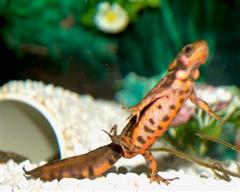Newt - Fire Belly
Japanese Fire Belly Newt, Japanese Fire Newt, Aka-Hara-Imori Scientific Name: Cynops pyrrhogaster
Mon, 28th April, 2025 - 12:18 pm GMT
Sponsor Ads:

Alternative Name
Japanese Fire Belly Newt, Japanese Fire Newt, Aka-Hara-Imori Scientific Name: Cynops pyrrhogasterBasic Info
The Fire Belly Newt is sometimes confused with the Chinese Fire Belly Newt; but these are in fact different newts all together. The Chinese Fire Belly Newt has orange coloring in the ventral area and is usually a darker color over all. The Fire Belly Newt is also a bit larger than the Chinese variety. The mature Fire Belly Newt will grow to an average size of 4 to 6 inches in length. They have granular skin, which is commonly dark brown or black. They have red speckled bellies. Large glands are seen on each side of their heads. The Fire Belly Newt is seen in other colorations, but this is the most common. Males can be easily distinguished from females at adulthood. The best way to differentiate between the sexes is to examine the tails. The male's tail has a purple tint and is flatter than the female's tail. The male's tail also has a string-like attachment that the females lack.
Health
Fire Belly Newts can be burned if you use a reptile light for their tanks. Incandescent or florescent lighting is recommended. Firebelly Newts are very hardy and have a long lifespan. The average lifespan for Fire Belly Newts ranges from 1 to 60 years depending on care. Make sure you house your Firebelly Newt in an escape-proof enclosure. Like other newts they are notorious for their ability to escape! Breeding In the wild, Fire Belly Newts will often breed after resting during the cool season. It is recommended to duplicate this when attempting to breed in captivity. Prior to breeding, it is recommended to lower tank temperatures to 40 degrees Fahrenheit. Lowered temperatures are used to simulate winter, and thus should last for approximately 45 to 60 days. Breeding tanks must be equipped with plants. Once ready to breed, temperatures should be increased. Males will initiate breeding by fanning their tail at the female. The fanning motion releases pheromones to attract the female. Once the female is interested, the male will hold the female around the neck; a process called "amplexus". The male will then drop a spermatophore on the ground and move the female over it. The female will then take the spermatophore into her cloaca. Once pregnant, the female will deposit her eggs on the plants within the tank. The eggs are fairly large and easy to see. The eggs will take somewhere between 12 and 17 days to hatch.Habitat
The natural habitat of the Fire Belly Newt is the cool, still waters of heavily vegetated ponds.Behavior
The Fire Belly Newt is known as the Japanese Fire Belly Newt, Japanese Fire Newt, and Aka-Hara-Imori in Japanese. By whatever name, this wonderful newt can make a great addition to even a beginning hobbyist's collection because they are relatively easy to care for and inexpensive. The Fire Belly Newt is quite mellow. The best time to find them being active is around feeding time. Captive Fire Belly Newts should be fed live food. Some good choices include, small earthworms, waxworms, bloodworms, crickets, and slugs. Feeder fish can also be given occasionally, but they should not comprise the entire diet. Some will also eat frozen food such as bloodworms. Many keepers also recommend vitamin supplements. Mealworms and Tubifex worms are not recommended. Fire Belly Newts may be intra-specifically aggressive, especially with a limited food resource. If they are kept in an over crowded and/or underfed situation they will quite often turn to cannibalism and/or mutilation. This can often be avoided if they are fed at least once daily, though twice a day feeding may be preferable. Signs of aggressive behavior include white plaques or ulcerations. Often times these may be mistakenly identified as symptoms related to poor water quality. Salt baths can alleviate the symptoms, but more space and more frequent feeding is the best way to prevent this problem. The Fire Belly�s enclosure should have a layer of substrate on the bottom. This can be made from gravel and rocks. Rocks should be large enough to poke out of the water to provide basking spots. The Fire Bellied Newt also seems to appreciate the presence of tunnels and other dark hidey places. Floating plants are also a nice addition to their enclosure. They will often float on them and will sometimes nibble on them as well. The captive environment should mimic their natural surroundings as much as possible. The Fire Belly Newt, like many amphibians, is largely aquatic. Some have reported exceptions, but generally they like to spend most of their time in water. They should always be given the option to move to and from land. A two-thirds aquatic to one-third land ratio seems to do quite well. A ten-gallon tank should sufficiently house two to three newts comfortably. If you wish to house more, a tank with more floor space is recommended. It is very important to change water frequently, as well as have a good filtration system installed. The filtration system should be set to a minimal water flow and not at all turbulent. A gravel and sand substrate is recommended. It is important to use large pieces of gravel as smaller pieces can be ingested. The sand should be placed underneath the gravel. The purpose of the sand is for plants. The gravel should be increased until it rises into your land area. Placing rocks or logs on the land area is recommended because it provides nice little hiding places. Some will cover the land area with moss and the Fire Belly Newts seem to like it. Plants are also a nice addition to the land area. Floating plants like elodea are wonderful decorations for the aquatic parts of the tank. The tank should also provide several dark hiding places for them as well. Temperature should be cool. They seem to do well at temperatures ranging from 60 to 70 degrees Fahrenheit. It has been reported that they will survive lower temperatures of 40 degrees, but this is not advised. If temperatures are too high, or they are overcrowded, Fire Belly Newts may experience appetite loss and other health problems, such as bloat, which can be a fatal condition. It should also be noted that bloat can be caused by the ingestion of plant matter, since this is a carnivorous species. All in all the Fire Belly Newt is easy to keep, as long as his requirements are met. These newts are great for beginners.Origin
JapanHistory
The Fire Belly Newt originates in Japan and parts of China.Common Foods
N/ASponsor Ads:
My heart Is true as steel. -- A Midsummer Night's Dream . Act ii. Scene. 1, William Shakespeare
Newt - Fire Belly
Coded by: BGID® | ALL RIGHTS RESERVED Copyright © 2000-2025
Disclaimer | Privacy | Report Errors / Contact | Credits








 President of the United States of America - Real Estate mogul, Pageant owner and now one of the most controversial men in political history.
President of the United States of America - Real Estate mogul, Pageant owner and now one of the most controversial men in political history.  Politician, US Vice President and President of the USA - Joseph Robinette Biden Jr.
Politician, US Vice President and President of the USA - Joseph Robinette Biden Jr.  versus
versus  Russia: 'The Evil Empire'? Are they all that bad or is it just the USA trying to portray Russia as bad because they are a world power with land bigger and a society very different from the USA ideal?
Russia: 'The Evil Empire'? Are they all that bad or is it just the USA trying to portray Russia as bad because they are a world power with land bigger and a society very different from the USA ideal?  Global warming has been in and out as the "latest" hot topic for many years. It is, according to modern scientists, the result of man-made industrial pollutants, clearing forested areas, agriculture, etc. But now they are thinking it started way before the Industrial Revolution...
Global warming has been in and out as the "latest" hot topic for many years. It is, according to modern scientists, the result of man-made industrial pollutants, clearing forested areas, agriculture, etc. But now they are thinking it started way before the Industrial Revolution... 
 Corona virus
Corona virus 
 Users with wide screen monitors can benefit from more content on every page.
Users with wide screen monitors can benefit from more content on every page.